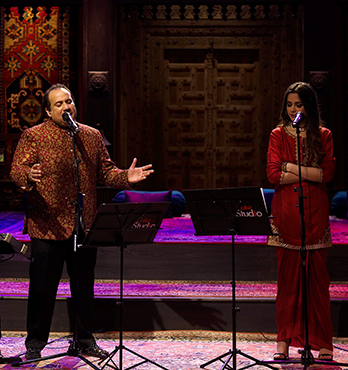Heeray

by Ayesha binte Rashid
A long time ago, when ascetics roamed the land and civilization moved at an easy, meandering pace, there lived a young man named Ranjha, born to the Jatt tribe of Ranjha in Takht Hazara, Punjab. The youngest son and his father’s favorite, ‘raaj dulaara’, Ranjha was a creative soul who spent his time playing the flute.
When his father passed away, Ranjha fell into a dispute with his brothers and left home, travelling south along the river Chenab that meandered through the land. His wandering brought him to Jhang, to the doorstep of the Sayyal chief of the village, where he found employment as a cowherd – and the beautiful Heer. Her beauty, it is said, matched that of the full moon, her lips as red as rubies, her eyes shining like daffodils.
Heer and Ranjha’s attraction was mutual, and instant – thus began a love story that continues to live on in the Subcontinent’s collective memory. The story of Heer and Ranjha has become a metaphor for true love which is eternal and without condition; a story that is still told some four hundred years after it was first told by the poet Damodar Das Arora. It was immortalized in culture’s memory in the words of Waris Shah, a Sufi poet who chronicled the saga in a poem that is still recited at gatherings, quoted for its wisdom, and performed in theatres.
Heer and Ranjha’s love, Waris Shah tells us, flourishes in secret for some years, in the fields and forests that surround Jhang. The couple’s bliss, however, is not meant to last very long – Heer’s uncle discovers their secret and brings it to Heer’s family, who is enraged that she would think to give her heart to a man from a lower social status than theirs. To protect their honor, they create a match for her with a man from the Khairra tribe in Rangpur village. At the marriage ceremony, Heer refuses to accept the nikah – her nikah, she says, has been made in the heavens with Ranjha, by none other than the Prophet himself. Enraged at her statement, the qazi of the ceremony forcibly pronounces the nikah and a broken-hearted Heer is carried off to Rangpur by the Khairras.
Grief-stricken, Ranjha strikes off into the world, roaming the jungles and fields of Punjab, yearning for his beloved and despairing over the loss of his love. He encounters a group of jogis, traveling ascetics, and joins their ranks, renouncing the material world. The jogis travel from village to village, collecting alms and end up in Rangpur, on the threshold of the Khairra household – fate once again delivering him to his lover’s doorstep.
Heer realizes that this young, strange jogi is her long-lost Ranjha and the two manage to elope only to be captured by the Khairras and brought before the raja of the land. The raja rules in favor of the Khairra family, declaring Heer to be their daughter-in-law, ordering her to return with them to Rangpur. Hearing this, Ranjha cries towards the heavens, asking God to bring punishment down upon the raja and his people – a prayer that is seemingly answered immediately when a fire erupts nearby. Seeing this as a sign from the Divine, the raja immediately overturns his ruling, gives the couple a chance to tell their story and, ultimately, rules in their favour.
And, so, Heer and Ranjha, after years of separation and turmoil, are free to be together. They return to Jhang, where Ranjha asks Heer’s family for her hand in marriage and they finally agree. Ranjha returns to his own home, to reconcile with his brothers so that he may bring a procession to Heer’s home and take her away as a bride. Years have passed since the brothers quarreled – he is welcomed back and preparations begin for a grand wedding procession. The story of Heer and Ranjha, however, is not a fairy tale ...
In Jhang, Heer’s family, determined to undo the ‘dishonor’ that has been caused to them by their daughter’s decision to love who she chooses, poisons the beautiful heroine of this tale. Hearing this, Ranjha rushes to Jhang to find that he is too late, that Heer has already left the world and, in his grief, decides to follow her – he eats the very sweetmeats that Heer has been poisoned with. Denied union in this world, the two lovers finally find it in death.
It is 2019 and Ustad Rahat Fateh Ali Khan takes on Coke Studio’s twelfth season, 400 years after the story was first told in Waris Shah’s poetry. “Sun Heeeere,” he calls out, “ teri doori dil cheere. Ni main ban gaya jogi, tere pyaar da rogi,” he recalls the pain that Ranjha once felt as he walked through the countryside, crying in despair for his Heer. Heeray is a modern retelling of the tale of Heer and Ranjha – Heer’s voice has been given to young Aima Baig, who takes the stage for her first collaboration with Khan Sahab.
For Khan Sahab, Heeray is an offering that refreshes the story and makes it contemporary; “We’re singing this story in a new genre so that the Heers and Ranjhas of today are able to relate to it. I feel like it’s not necessary for me to retell this story in my own style and what’s easy for me. There are different styles of doing music and I wanted to try something new.”
Ultimately, for Khan Sahab, the story of Heer and Ranjha is a reminder that while it may tread upon a path strewn with challenges and sacrifice, the idea of true selfless love is not a myth: “An aashiq has to court death, bear wounds, and give sacrifices for love. Being anaashiq is not easy. Love is most extraordinary, but also most painful.”
